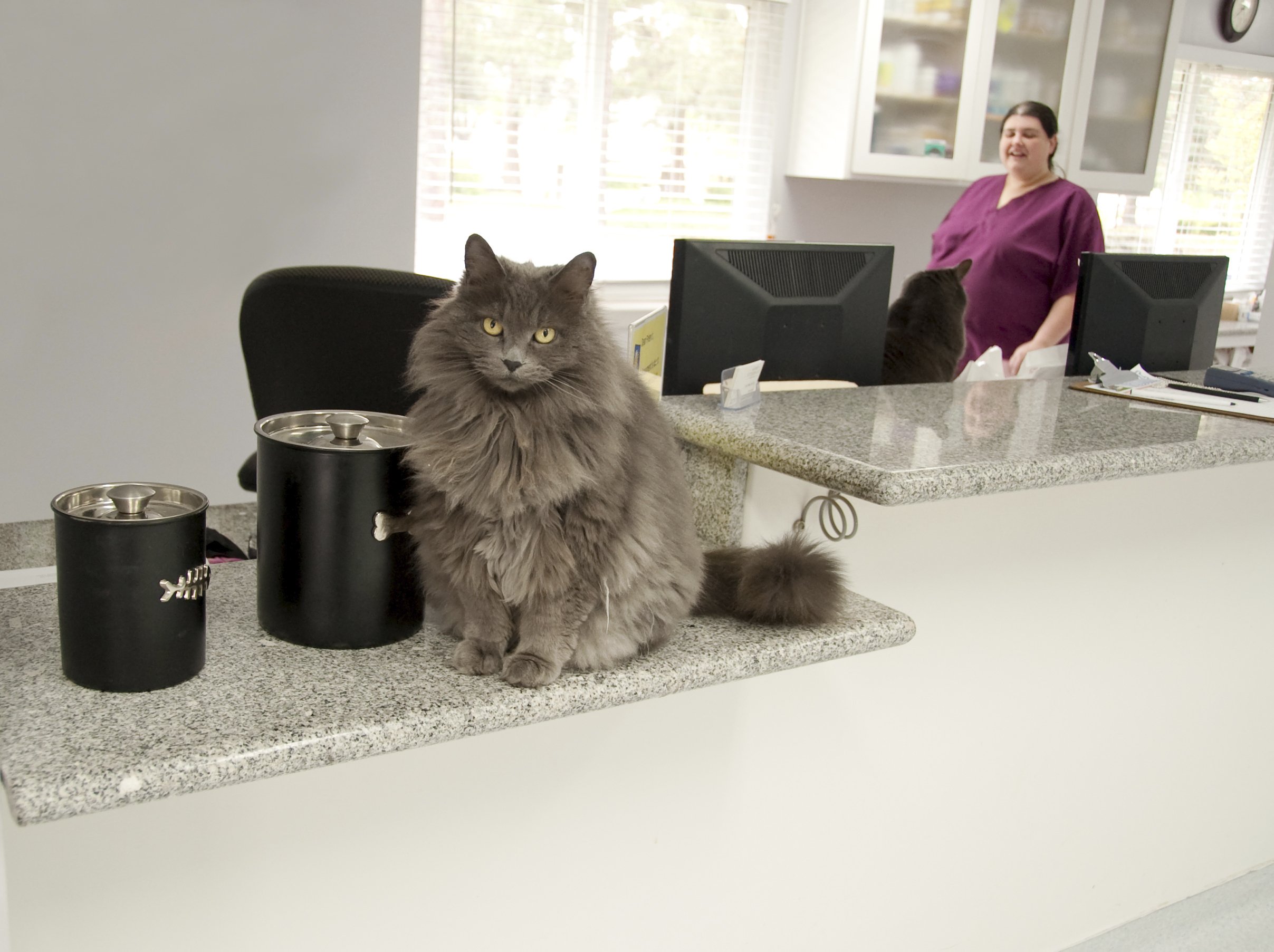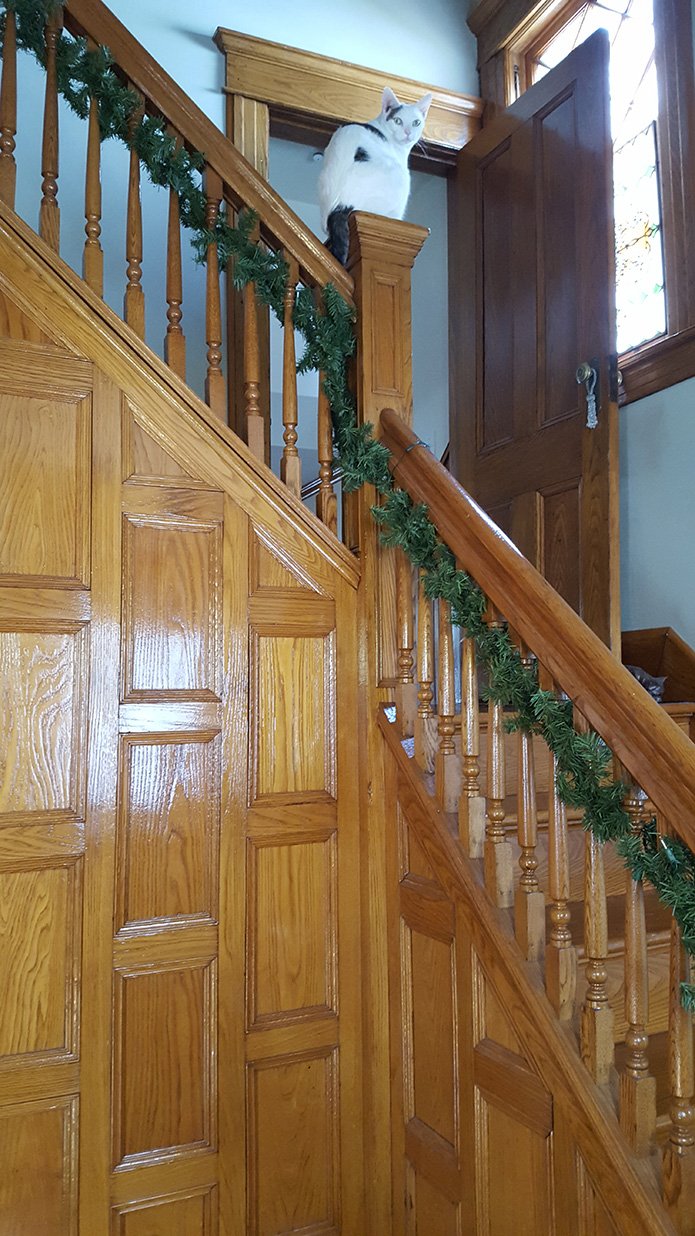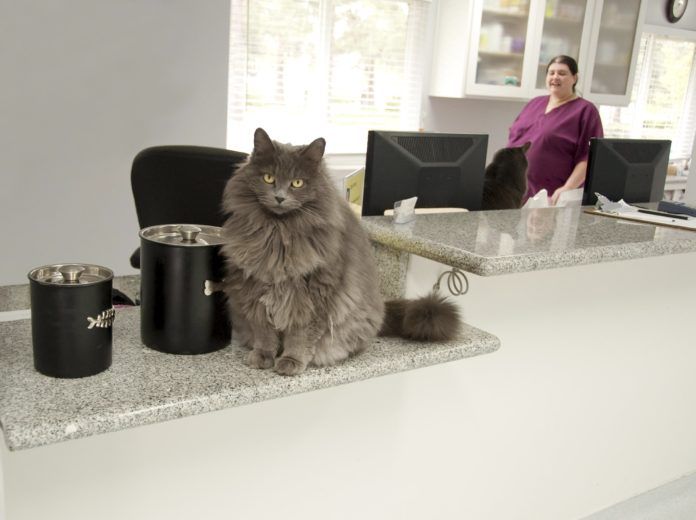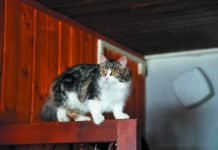THINKSTOCK


Cats are graceful, sinewy and powerful creatures, and we understandably marvel at their natural athleticism. The feline physique is built of strong hindquarters and a supple spine, which allow them to effortlessly jump horizontally and vertically. Amazingly, a cat is capable of jumping up to five to seven times its own height — usually lightning fast and whisper-quiet.
Whether they’re leaping out of the bushes to capture prey, stashing the prize high up in the treetops or leaping onto our kitchen counters, the simple reality is that cats jump. Whether or not counter jumping is an “acceptable” behavior definitely varies from home to home. Some owners don’t particularly mind the elevated exploration, while others can’t stomach “litter box paws” padding across the surfaces of counters where food is prepared and/or eaten.
Jumping is in their nature
“By nature, cats are three-dimensional creatures with a vertical dimension that is part of their natural inclination,” explains Nicholas H. Dodman, BVMS DACVB, Director of the Animal Behavior Clinic at the Cummings School of Veterinary Medicine at Tufts University. “They are not confined to the ground; they will try to get as high as they can in order to safely observe the world around them. In the home, they’re not going to spend most of their time with ‘four on the floor’ like most dogs. They are going to go up on elevated surfaces such as tables, furniture, counters and beds. It’s natural for cats to want to do that.”
Not all cats jump on kitchen counters per se, but all cats do naturally seek elevated surfaces. Therefore, it’s imperative to provide appropriate vertical space for your cat, especially indoor-only cats. Providing a variety of elevated surfaces — including multi-level cat condos with a nesting box, window seat perches (some come with optional cushions and heat pads) and the use of ladders, steps or stepping shelves to elevated “catwalks” around the upper parts of walls — will go a long way to keeping an indoor cat happy and satisfied with his environment.
Most homes have largely unused wall space that is perfect for creating vertical space for cats. Ideally, there will be a window view. “Not providing a three-dimensional environment for an indoor-only cat is not thinking logically about your cat’s behavior, needs and wants. They do want to go up and if you try to prevent them from doing so, you are fighting against the tide of their nature,” says Dr. Dodman.
Common training methods
In addition to environmental enhancement, there are several methods used to modify behavior — for example, clicker training, remote punishers and aversive techniques. But when it comes to modifying a natural behavior (such as jumping), it certainly presents specific challenges.


How clicker training can help
Clicker training your cat to get up on a surface, and then down, is one option, according to Dr. Dodman. You can use a magic wand pointer with an object on the end of it, like feathers or a toy, because these are appealing to nearly all cats. As you tap the pointer, the cat will probably run to it, wanting to explore it and bat at it with its paws.
Begin by tapping on the floor, and when the cat runs toward the pointer and touches it, you should click and reward the cat for touching it. Next, touch the counter, tap-tap; then touch the floor, tap-tap. Repeat the steps, but this time adding the word ‘up’ for jumping up and ‘down’ when on the floor.
Each successful accomplishment is rewarded with a click and a highly-valued food treat. Theoretically, you’ve taught your cat the words ‘up’ and ‘down’ so if your cat is on the counter, you say “Down!” When the cat jumps down, you offer the reward. “It won’t stop the cat from jumping up, of course, because whenever you’re trying to train against nature you’re on a losing mission. But it is better than yelling at your cat or pushing him down with your hand,” says Dr. Dodman.
For some, there is also the concept of making counters, tables and furniture unappealing spots by using “remote punishers.” Remote punishers punish the cat while you are not there, and the cat will subsequently associate the behavior (such as jumping on counters) with an unpleasant experience. Whether manufactured devices (“Scat Mats,” etc.) or homemade creations (cookie sheets filled with water, aluminum foil, double-sided tape), all are intended to startle the cat.
However, the use of remote punishers — especially for skittish cats — could potentially make a nervous cat afraid of freely roaming around your home and interacting with you. Dr. Dodman strongly cautions, “I know them all well. You could argue that with remote punishers the owner doesn’t get the blame, but it still is likely to damage your relationship with your cat. And mats that emit electric shock can literally terrify some cats, in addition to the pain that they cause for the animal.”
Aversive tactics are damaging
Dr. Dodman feels that the least effective training methods are the use of aversive tactics and physical punishment. An example of aversive method is spraying your cat with a water pistol whenever he jumps on the counter. Never hit, shove or push your cat off the counter. These actions won’t teach your cat to stay down. Instead, they could hurt your cat, and will most likely just make your cat afraid of you. “Physical punishment delivered by a person — whether it is running towards your cat, clapping your hands, bellowing ‘Get down!’ or using a water pistol or air horn — doesn’t prevent your cat from jumping on the counters. Additionally, it does nothing to improve your relationship and could potentially create a terrified cat that avoids you,” stresses Dr. Dodman.
Maybe it’s time to … accept it
Far easier than trying to train against the cat’s nature to jump, Dr. Dodman feels that it’s probably easier to teach people to accept it. Cats are fastidious animals, says Dr. Dodman. “Urine is sterile, and though it sounds unpleasant, cat feces of a healthy cat are non-toxic. Of course, cats can have some medical conditions — like toxoplasmosis, urinary tract infections or diarrhea — but those conditions should be treated by a veterinarian anyway. People let their cats climb on them, snuggle with them and lick them — and very few become ill.”
Rather than trying to stifle your cat’s natural behavior, the best approach is to provide your cat with far more interesting areas for jumping and climbing, and safe escape routes from which to survey and explore their indoor environment. By accepting your cat’s natural behavior and equipping your home with a variety of cat-friendly vertical space, you can rest easy when nature beckons to your cat, “surf’s up!” — Ramona Marek, Ms Ed.




